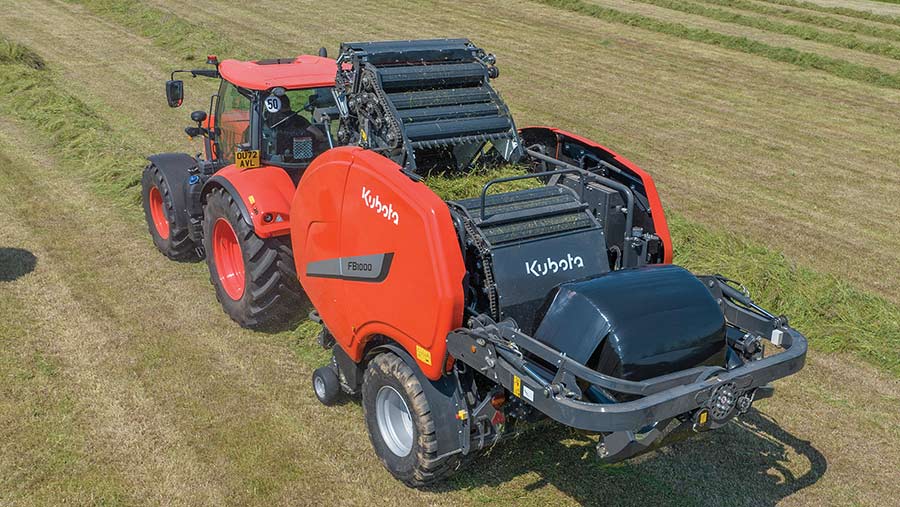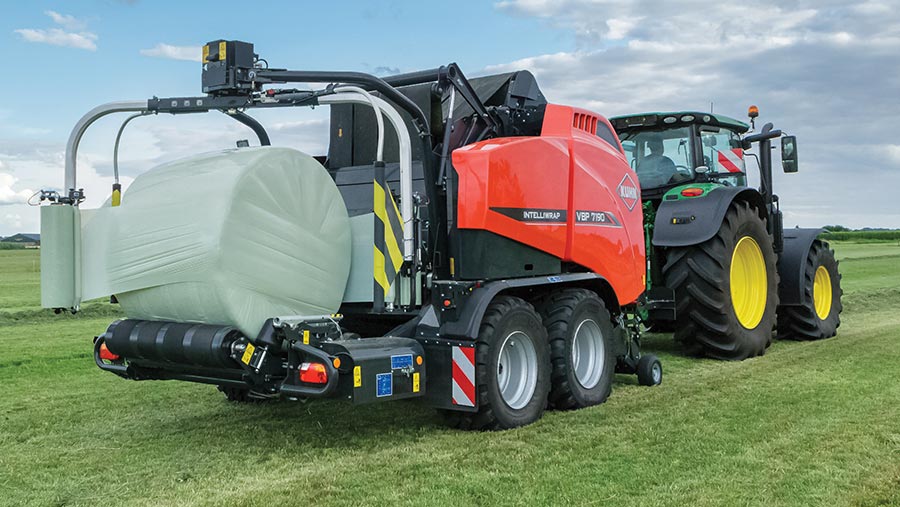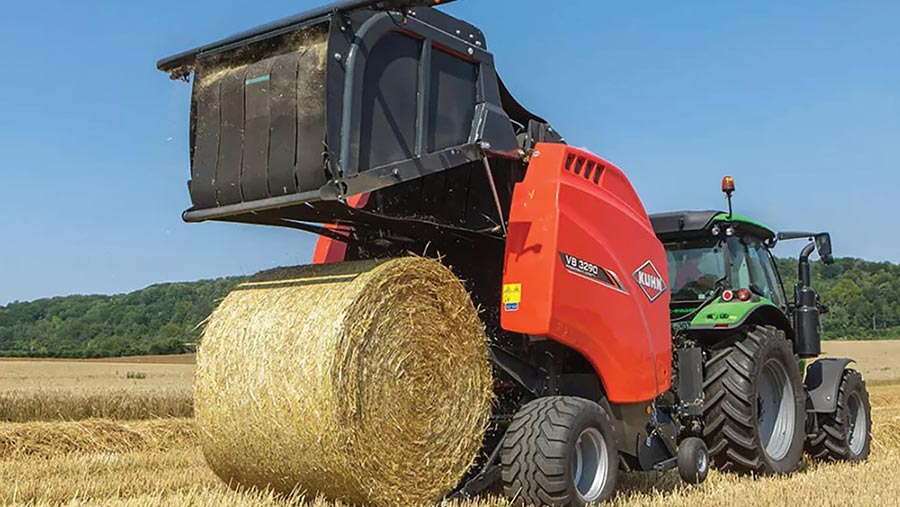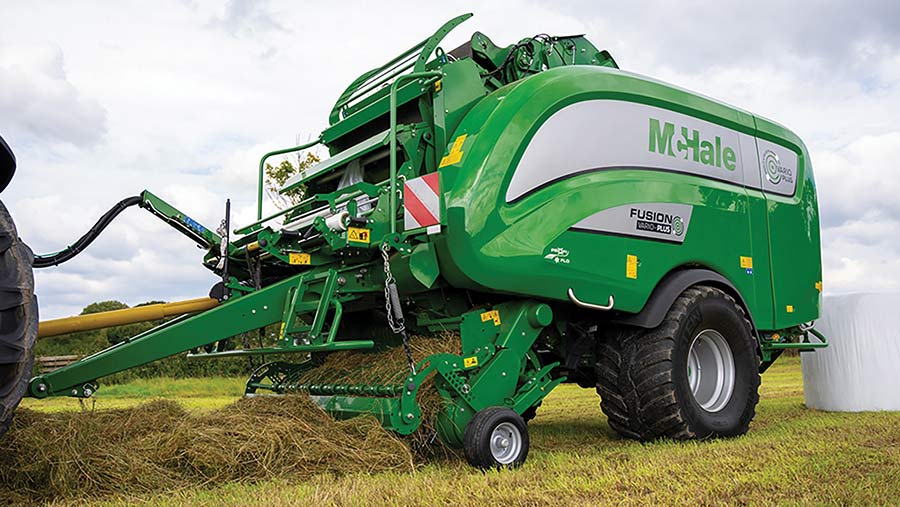Ultimate guide to buying a round baler 2024
 New addition – Kubota FB1000 non-stop baler-wrapper © Kubota
New addition – Kubota FB1000 non-stop baler-wrapper © Kubota New balers and baler-wrappers – mostly promising increased output and denser forage packing for fewer bales per field and storage stack – feature in this year’s Ultimate Guide to round balers.
See also: Driver’s view: Andrew Sommerville’s Vicon Fastbale baler-wrapper
Round baler specs
Download the complete 2024 buyer’s guide to round and square balers
Kubota
The two variable-chamber combination baler-wrappers previously offered in the Kubota range have been dropped, namely the BV 5160 Plus and the BV 5200 Plus, both featuring the FlexiWrap film application system.
In their place, Kubota has brought in the non-stop baling and wrapping FB 1000, which makes bales of a fixed 1.25m diameter continuously.
Grass is first accumulated in a 17-roller front chamber while the previous bale is being finished off and wrapped.
The partially formed bale is then transferred to the second chamber, where further layers and net are applied ready for moving on to the wrapping table.
Also joining the range is a non-crop slicing version of the BF 3500 all-roller baler, which has previously been available only with a 15-knife cutting mechanism.
Kuhn

BalePack combinations join regular Kuhn 7100 series balers © Kuhn
More substantial changes have been made to the Kuhn line-up, including the introduction of the VB 3200 series variable-chamber balers and VBP 3200 baler-wrapper combinations as improved replacements for the equivalent 3100 series machines.
Kuhn reckons the new versions offer 10% more output capacity and also a 10% increase in bale density in dry crops such as hay and straw compared with their predecessors, the latter as a result of the Progressive Density Plus pressure boost mechanism.
Capacity gains are attributed to a new heavy-duty crop roller and spring-loaded tines that pre-compress the incoming crop into a more compact swath before it reaches the intake rotor.
At the end of the bale rolling and netting process, the tailgate now lifts and lowers faster to cut bale discharge time to just six seconds.
Durability, meanwhile, is further improved by installing stronger main and rotor drive chains, and upgrading the reinforced bearings and seals for rollers under the greatest stress.
As before, there are OptiFeed non-chopping and OptiCut chopping versions of the revised balers, the latter with a choice of 14-knife and 23-knife assemblies.

Intake and density upgrades feature on Kuhn VB 3200 series balers © Kuhn
Also introduced are bale wrapping versions of the high-specification 7100 series balers featuring the i-Dense “intelligent” density system.
This uses two tensioning arms – as opposed to the single arm of the 3200 series – each having two hydraulic cylinders to apply pressure to the four bale-forming belts.
With automatic moisture sensing also part of the package, automatic pressure/density adjustment can be engaged for more consistent bale weights in fields where moisture content varies.
The orbital arm IntelliWrap system enables operators to add an extra layer (or subtract one) when required, rather being limited to the more common even number of layers only.
So-called 3D wrapping applies film to the shoulders first, then the rest of the circumference and the end sections, and the new baler-wrappers can also apply film instead of net using the twin pre-stretch dispensers at the front of the machine.
McHale

Increased capacity comes with McHale’s Fusion Vario Plus © McHale
For baling and wrapping in a combined operation, McHale has replaced its existing Fusion Vario model with the upgraded Fusion Vario Plus, which makes bales of 60cm to 1.68m diameter in straw and hay, and 1m to 1.45m in haylage and silage.
The Plus specification indicates that the machine can apply stretch film to the barrel of the bale – as is already available on the fixed-chamber balers and baler-wrappers – to provide an extra layer of wrap and a common material for recycling.
Increased bale density through an improved belt tensioning system, a tailgate that lifts only as far necessary to eject a given diameter of bale, speedier bale transfer from baling to wrapping sections, and faster wrapping speeds are said to contribute to greater output from the machine.
Up front, there is a heavier duty driveline and revised intake area that automatically adjusts to the volume of incoming material.
The pick-up now lifts forage into a tapered channel, where the side augers have been moved further forward and angled towards the intake rotor for improved crop flow.
Operation is improved by installing isobus electronics as standard, enabling users to set up and monitor various functions using a tractor’s built-in or third-party display, including McHale’s own Iso-Play terminals.
Bale weighing and moisture measurement are among the options that can be specced.
McHale has also added isobus to create top-spec versions of the V6700 series variable chamber baler, producing packages up to 1.68m diameter, and the V8900 series 1.9m machine.
Vicon
A non-chop version of the FixBale 500 has been added to the Vicon range, this being a model with an intake rotor but no knife system to complement the existing version with a 15-blade crop slicing setup.
The FixBale uses 18 steel rollers to form bales 1.25m in diameter, with bale density determined by hydraulic resistance at the tailgate.
A bale-and-wrap combination is out of the range, however, with the RV 5216 Plus FlexiWrap having been dropped, leaving the FastBale non-stop machine as Vicon’s only wrapping baler.
This machine rolls up grass in a chamber before the juvenile bale is transferred to a second chamber where it is completed and netted, then moved to a wrapping table.

